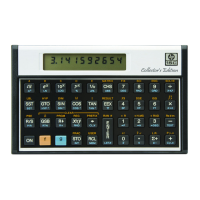86 Section 7: Program Editing
| ¥
Run mode.
´ CLEAR Q
Clear storage registers.
t A
Move to first line of program
A.
8 O 1
8.0000
Store a can height.
2.5 2.5
Enter a can radius.
 (hold)
001-42,21,11
Keycode for line 001 (label).
(release)
2.5000
Result of executing line 001.
Â
002- 44 0
O 0.
2.5000
Result.
Â
003- 43 11
| x.
6.2500
Result.
Â
004- 43 26
| $.
3.1416
Result.
Â
005- 20
*.
19.6350
Result: the base area of the
can.
Wrapping. Â will not move program position into “unoccupied”
program territory. Instead, the calculator will “wrap around” to line 000.
(In Run mode, Â will perform any instructions at the end of program
memory, such as n, t or G.)
Line Position
Recall that the calculator’s position in program memory does not change
when it is shut off or Program/Run modes are changed. Upon returning to
Program mode, the calculator line position will be where you left it. (If you
executed a program ending with n, the position will be at line 000.)
Therefore, if the calculator is left on and shuts itself off, you need only
turn it on and switch to Program mode (the calculator always “wakes up”
in Run mode) to be back where you were.

